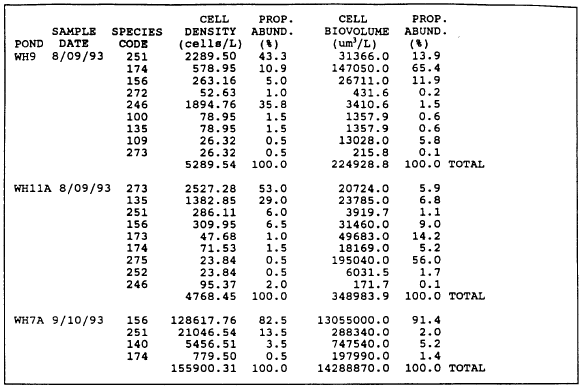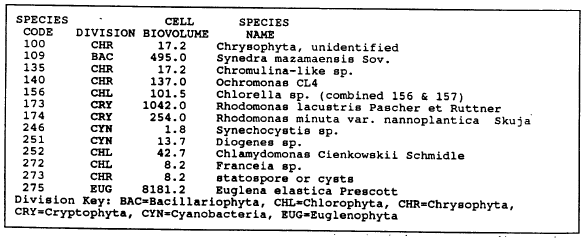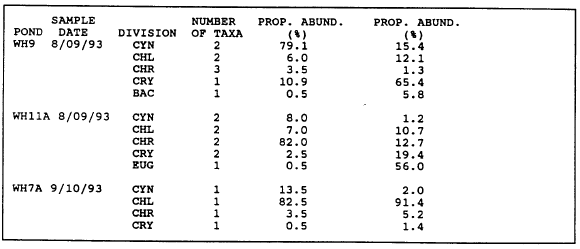3.2 Plankton
3.2.1 Phytoplankton
Three phytoplankton samples were obtained from three different ponds (Table 4). Pond WH9 was sampled on August 9, 1993, as was pond WH11A. Nine alga taxa were identified in both ponds. Pond WH7A was sampled on September 10, 1993, and only 4 taxa were identified. The species number and their corresponding division, individual species biovolume and species name are arranged in Table 5.
Ponds WH9 and WH11A, both collected on the same date, show many similarities quite different from pond WH7A (Table 4). Nine taxa were identified in WH9 and WHl lA, both had similar total cell densities (5289.54 and 4768.45 cells/L, respectively) and biovolumes (224928.79 and 348983.87 gm3/L). Pond WH7A, with 4 taxa, had a total cell density of 155900.31 cells/L and total biovolume of 14288870.0 [tm 3/L.
The dominant taxa varied for each pond (Table 4). Pond WH9 was dominated byDiogenes sp. and Synechocystis sp., both cyanobacteria with combined cell density of 79.1% and the cryptophyta were 10.9%. In cell biovolume the cryptophta were dominate (65.4%) and the cyanobacteria were greatly reduced (15.4%). Pond WH1 lA was dominated by a statospore (or cysts) and Chromulina sp., both chrysophytes and had a combined cell density of 82.0% and euglenaophyta had 0.5%. The cell biovolume was 12.7% and 56.0% for chrysophta and euglenaphyta, respectively. Pond WH7A had only one taxa dominate (both in cell density and biovolume), Chlorella sp., in the division chlorophyta (Table 4).
|
Table 4. Ponds sampled for phytoplankton, date sampled, species codes, cell density and biovolumes, and their proportional abundances. |
|
Table 5. Phytoplankton species identified and their corresponding codes, divisions, and individual cell biovolumes. |
On a divisional level, all ponds had a fairly even distribution (Table 6). Pond WHi 1A had two taxa each of Chlorophyta, Chrysophyta, Cryptophyta, and Cyanobacteria; and one taxon of Euglenophyta. Pond WH7A had one taxon in Chlorophyta, Chrysophyta, Cryptophyta, and Cyanobacteria. Pond WH9 was slightly different with three Chrysophyta, two Chlorophyta and cyanobacteria, one Bacillariophyta and one Cryptophyta.
|
Table 6. Phytoplankton samples compiled into taxonomic divisions, number of taxa present, and their proportional abundance |




